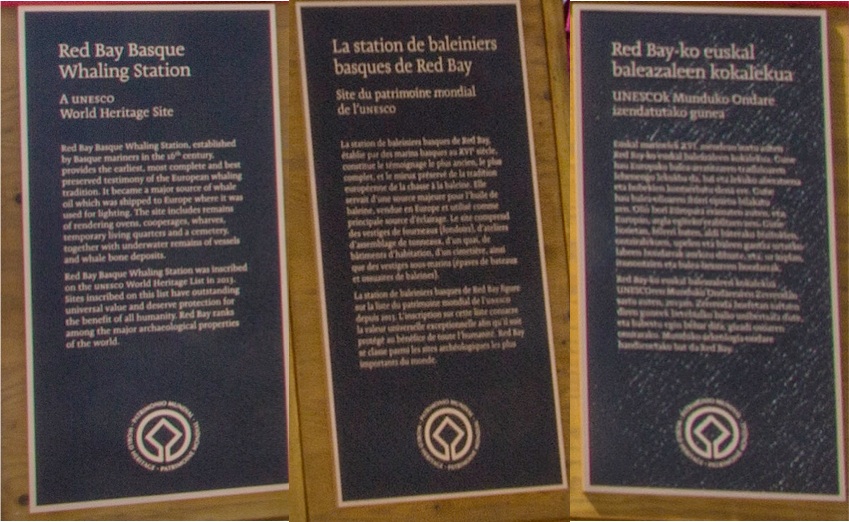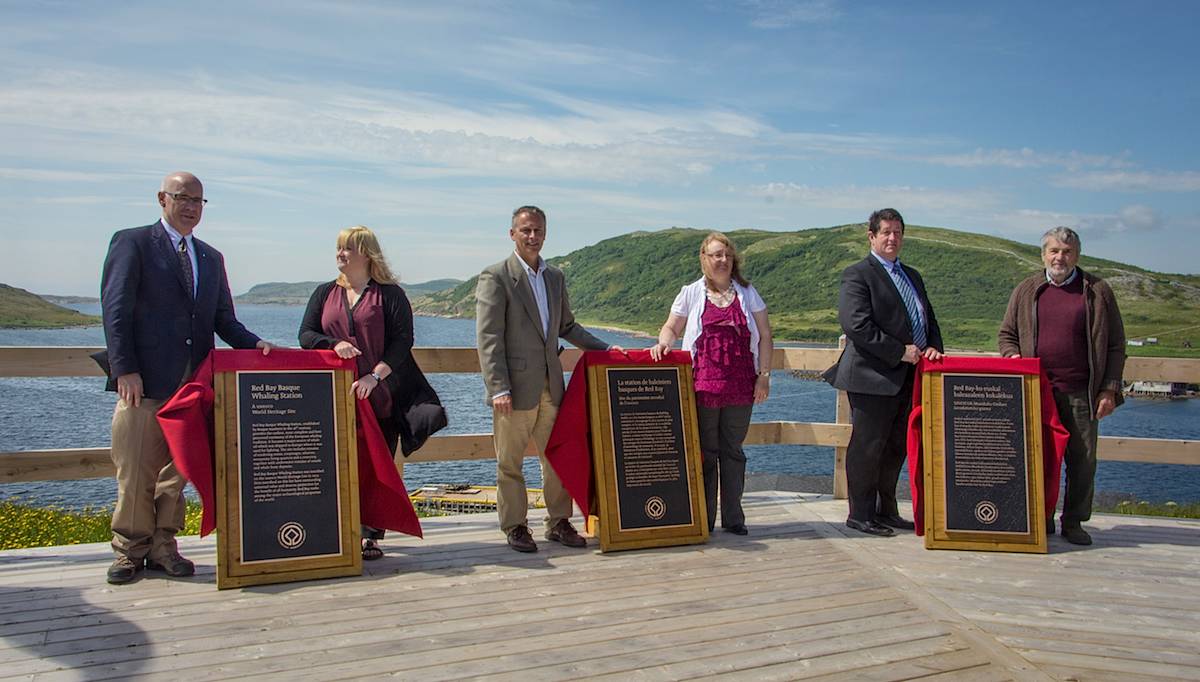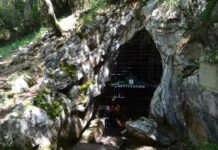This article was translated by John R. Bopp
There are matters where we get the impression that either we’re obsessed or we have a completely different point of view to the rest of the world. Just one of these situations would explain why we thing, it would seem wrongly, that the presence of Basque authorities is necessary when UNESCO dedicates the Basque Whaling Station at Labrador as a World Heritage Site, but that did not happen.

We say it would seem our perception must be wrong because neither during the process nor the celebratory events for such an extraordinary event for the Basques were there any representatives of Basque institutions. In this last occasion, the one that inspired this entry, the event in which there was no Basque representation was the laying of the plaques recognizing the Red Bay Basque Whaling Station as a World Heritage Site.
It’s true that the Basques were represented by the spirit of the seamen from the Basque Coast who went to those lands for centuries. We could even think that the Basques were directly represented by the Basque seamen who died in those lands and were buried in the Basque cemetery there in North America, which is preserved even to our day.
With all our respects to the Canadians, this Basque Whaling Station, located on what is now their coast, is an “unexpected gift”, since it was built with the hard work and effort of the Basques who went there for hundreds of years, from all parts of the Basque Country, from Bayonne to the western limit the Land of the Basques had at that time, it was they who created that bit of history that is now on Canadian shores.
There, Basques not only left their dead, their effort, or the remains of the first industrial facilities in North America. They left so much more. In their relations with the First Nations they dealt with, they left their language. In their trade relations, they left behind the first iron tool. They even left the first document ever written in North America.
In the end, there are too many things for us to be able to understand, or accept, that Basque Institutions do not play, or indeed demand, a more active role regarding this People’s heritage on the other side of the Atlantic. We know there are difficulties in international relations when one’s Nation has no State. But today, sub-national international relations are such a powerful reality that not even the centralist French and Spanish states can ignore or impede it.
As we said, what UNESCO just declared a World Heritage Site is a Basque reality. That’s why we don’t understand why, at such an important event as the laying of the plaques remarking on that designation, there was no Basque representation. We’re aware that the Basque Government sent a letter and a video from the Lehendakari, just as Irekia pointed out. Curiously, the letter was sent by the Department for the Environment and Territorial Policy, when we would have (humbly) thought it more logical for the Department for Culture to send it, or even the Executive Department itself, as that is where the body responsible for International Relations is in the sub-national government that represents the majority of the Basques. But that’s just a comment on something we found odd.
What matters about the letter and the video is that not a single word of them was mentioned in Canadian media when they were talking about this, not even in the official note published by the Government of Newfoundland and Labrador on their website. This surprised us. We don’t feel that the letter, or the video, can substitute for the presence of an official representative of the Basque Government.
At this event, UNESCO laid three plaques, one for each of the languages “involved” in this story. Two were in English and French, the official languages of Canada. The third was in Basque, the language of those who worked on those lands. Among those who were there, none of them, surely, was able to understand a word of that plaque because again, the Basques were absent at this celebration of a fundamental part of their own history.
Newfoundland and Labrador Gov – 23/7/2014 – Canada
World Heritage Site Plaques Unveiled at Red Bay, Labrador
The Red Bay Basque Whaling Station was officially celebrated as a United Nations Educational, Scientific and Cultural Organization (UNESCO) World Heritage Site today, with the unveiling of three plaques – one in English, one in French and one in Basque. The site, designated by the World Heritage Committee in 2013, includes the remains of 16th century Basque whaling ships and shore stations which once supported a thriving whaling industry. The Honourable Nick McGrath, Minister of Transportation and Works and Minister Responsible for Labrador and Aboriginal Affairs, attended the ceremony on behalf of the Provincial Government.
(Follow) (Automatic translation)
—————————-
NL News – 23/7/2014 -Canada
Red Bay World Heritage plaques unveiled

today, during an official ceremony.(L-R) Mr. Bill Goulding, Department of Fisheries and Oceans; Ms. Lael Hird, Town Resident; The Honourable David Wells, Senator, Government of Canada; Her Worship Wanita Stone, Mayor of Red Bay; The Honourable Nick McGrath, Minister of Transportation and Works and the Minister responsible for Labrador and Aboriginal Affairs; and
Robert Grenier, Chief Underwater Archaeologist with Parks Canada, Retired.
Residents of Red Bay, Labrador and the surrounding Labrador Straits region watched on today during a formal ceremony as three UNESCO plaques – one in English, French and Basque – describing the international significance of the Red Bay Basque Whaling Station World Heritage Site were unveiled. The approximately 600 hectare World Heritage property that takes in a wealth of terrestrial and submerged cultural resources related to 16th century Basque whaling was designated by the World Heritage Committee when it met in Cambodia last year.
(Follow) (Automatic translation)
————————————
Yahoo – 23/7/2014 – Canada
Residents Celebrate Red Bay’s World Heritage Site Designation During Town’s Come-Home-Year
Residents of Red Bay, Labrador and the surrounding Labrador Straits region watched on today during a formal ceremony as three UNESCO plaques – one in English, French and Basque – describing the international significance of the Red Bay Basque Whaling Station World Heritage Site were unveiled.
(Follow) (Automatic translation)
————————————
WTOC – 23/7/2014 – USA
Residents Celebrate Red Bay’s World Heritage Site Designation During Town’s Come-Home-Year
Residents of Red Bay, Labrador and the surrounding Labrador Straits region watched on today during a formal ceremony as three UNESCO plaques – one in English, French and Basque – describing the international significance of the Red Bay Basque Whaling Station World Heritage Site were unveiled.
(Follow) (Automatic translation)
————————————
Metro – 23/7/2014 – Canada
Plaques mark whaling station as World Heritage site in Labrador
Three plaques have been unveiled to mark the designation of the Red Bay Basque Whaling Station in Labrador as a UNESCO World Heritage site. The station was recognized last June as Canada’s 17th World Heritage site and includes the remains of 16th century Basque whaling ships and shore stations that once supported a thriving whaling industry.
(Follow) (Automatic translation)
———————————–
Last Updated on Dec 20, 2020 by About Basque Country






























